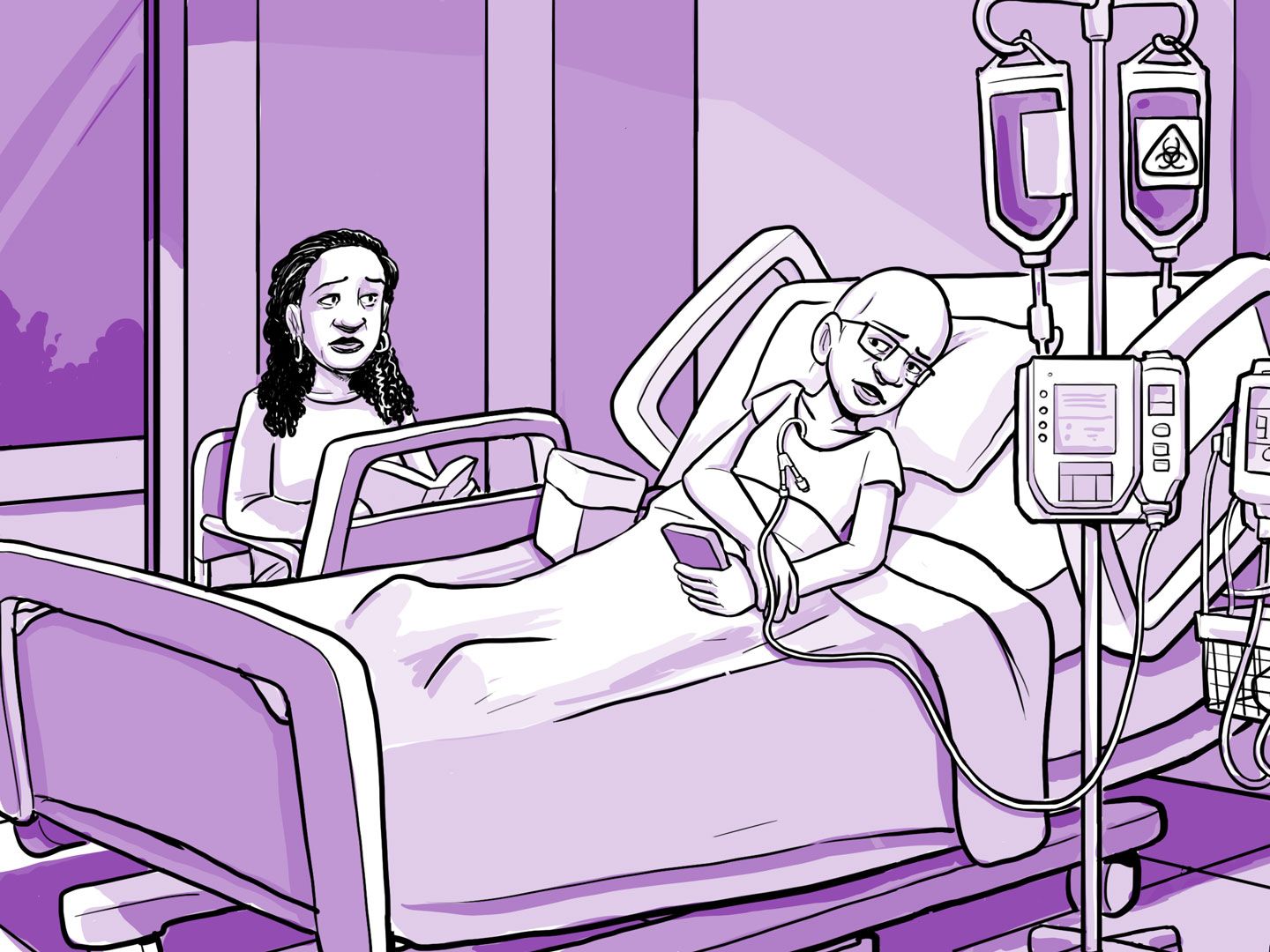Over the next several days
Over the next several days
You will get chemotherapy every day for 1 to 2 weeks.
This is sometimes called the “conditioning regimen” or the “preparative regimen” or “prep.”
- The medicine is given to you through an IV tube that puts it directly into your blood stream.
- You will be awake when you get this medicine.
- Your doctors will decide how much you need and how many times each day you will get the medicine.
Chemotherapy can cause problems (side effects).
Here are common side effects that can last a few weeks:
- Hair Loss. Your hair will start to grow back in a few weeks, but it might look a little different.
- Stomach problems. Many people vomit (throw up) and have diarrhea (watery poop). You can also have nausea (feeling sick in your stomach) and pain in your belly. You will get medicine to help control this. Some people feel like they do not want to eat anything.
- Pain.
- Headaches.
- Fevers.
- Mouth sores (painful spots in your mouth). If it becomes hard for you to eat, your doctor can provide nutrition to your body through a tube.
Other side effects can last longer:
- For about 6 months, you can get very sick from germs.
- You might not be able to have children, because chemotherapy can damage eggs and sperm. Talk to your doctor about freezing eggs or sperm cells before chemotherapy.
Some people have gotten cancer after chemotherapy, but it is not common.
-
A few people have developed leukemia (a type of blood cancer) after bone marrow transplant. This could be due to the chemotherapy.
-
Your doctor can talk to you about the latest information.
Chemotherapy helps bone marrow transplant work.
Before donated blood-making stem cells are put into your body, you need chemotherapy.
- Your old blood-making stem cells take up space. These are the cells with the wrong instructions. They make sickle cells.
- Chemotherapy kills your old stem cells to stop them from making sickle cells.
- This makes room in your body for the donated stem cells.
Chemotherapy kills any cells that your body makes over and over again.
- It can be used to kill cancer cells in people with cancer.
- It also kills stems cells.
- It kills egg cells and sperm cells.
- It also kills the cell that make up the moist, inner lining of some organs and body cavities, such as the mouth, stomach, and gut (intestines).
- It also kills hair cells. This is why your hair falls out. The cells that make your hair do not die, so your body can grow hair again after a few weeks.
After chemotherapy, you can get sick.
When chemotherapy kills your blood-making stem cells, your body cannot make white blood cells (immune system cells).
- The immune system is what protects you from germs.
- Without white blood cells (immune system cells) your body cannot fight germs.
- After chemotherapy you can get very sick, because you are immunosuppressed (unable to fight germs) for about 6 months.
- After 6 to 9 months, your genetically-changed stem cells have made enough new white blood cells for you to fight germs like you did before chemotherapy.
- You will need to get vaccinated again for several germs, even if you had gotten those vaccines as a child.
Medicines used for chemotherapy
- Busulfan
- Melphalan
- Thiotepa
- Cyclophosphamide
- Fludarabine
- Anti-thymocyte globulin (ATG)
- Alemtuzumab
Doctors can try different types of chemotherapy.
-
Myeloablative is a very strong dose of chemotherapy. It causes more side effects and has the highest chance to kill all the old blood-making stem cells. This is how transplants were first done for SCD, and many places still use this high dose method to do transplant. Using such high doses of chemotherapy reduces the risk of rejection, but it is associated with other complications such as organ damage and a higher chance of death.
-
Reduced intensity is lower in dose and toxicity than the myeloablative regimen. It is still very strong but causes fewer side effects than myeloablative doses. The risk of organ damage and death is lower with this. However, there is a higher risk of rejection.
-
Non-myeloablative is the lowest intensity. Sometimes it does not even use any chemotherapy. It is the least strong and has the least risk of organ damage. But it can increase the risk of rejection a lot. Patients may need to take other medicines to reduce the risk of rejection for a very long time after this type of transplant. Some patients who received a non-myeloablative transplant later developed leukemia, so many doctors are abandoning this approach.
